 This Is Not A
BLOG!
This Is Not A
BLOG!
Date: 21/10/17
School's Out - Forever
Warning! Long autobiographical piece follows! Warm clothing and light rations are advised!
It is a melancholy thing when the familiar landmarks of your life start to disappear. Be they cultural, personal or something more concrete, their removal from the world provokes such feelings of unease that nothing quite seems right anymore. They are memento mori by their absence rather than by their presence (memento mori is the plural form as well; I checked). Rather like a lost tooth (or, in extreme form, a lost limb), one's awareness of the empty space left is dislocating, especially if - like me - you are constantly aware of the temporariness of the world and all that's in it.
When such a part of your life is literally a landmark as well, then loss is added to discombobulation to create a whole syndrome of wrongness.
Before you read any further, please peruse this page.
Back? Good. Thank you.
There was an inevitability about what has just happened, I suppose. The building which used to house St. Mary's School up until about 1975 had been left to rot from the inside, and it was a sure thing that the hulk would be eyed-up by property developers and builders with a view to a chance.
And so it was that, a couple of years or so ago, a local building firm put in an application to raze a building which had stood there for nearly 140 years and replace it with even more of those breeze-block palaces which have grown like mould over so much of our village over the last twenty-five years (and Engedi chapel on High Street is next in the line of fire).
I saw the application and some of the photographs which had been taken inside the building in connection with it. Much of the interior - the floors especially - had gone beyond all help, and the almost wilful neglect of the owners in the intervening years since its closure as a school was readily apparent in every way.
Down with it, then; the patient was beyond salvation.
A week last Thursday (the 12th), I came home on the bus to find that the demolition process - which had already taken much of the interior - had begun on the structure of the building itself. In an instance of 'last up, first down', I saw that the top end of the old Infant School - which was erected as late as 1910 - had lost its roof and all bar the bottom five feet or so of external wall back to the main chimney piece. The place where I had first - with the deepest possible reluctance - entered into the world of formal education in September 1966 had vanished; the classroom of the 'nursery' class, the staff room, the 'pegs'; all gone.
I resolved that - unless the weather were inclement - I would come down with my camera on the Saturday afternoon and take some pictures of what was left.
I didn't really feel like going out on Saturday, even though the weather was fine enough; but I forced myself, and walked along Penygraig Road and down The Big Hill (does anyone under 45 years of age here call it that now?). I had intended going past the George & Dragon pub and down The Lane (does anyone under 45...well, you get the concept) so that I could start shooting from the bottom end up. Unfortunately, I let my mind wander, my feet automatically led me to turn right at the bottom of the hill, and I was past the kebab house before I realised where I was going. So, I carried on down to by our village pharmacy (one of the few amenities we still have left) and turned left...
...To find that the demolition boys had been very busy on the Friday, because now the whole of the Infants' had gone, along with the top half of the old Junior school right down to where the wooden steps used to lead up from the bottom-most level of classrooms. As with the first stage of the destruction, the outer wall on the road side had been left standing to a height of five or six feet (the road is going to be closed in a week or so's time, probably to enable the disposal of the wall and all the other rubble).
I took pictures in something of a daze; I knew that this was coming, and that it was unavoidable, but it was still an unnerving sight. I got into conversation with a former school-mate (hello, Barry!) who lives opposite and was coming back from walking his dog. It was the sort of conversation one has after funerals, where one superficially remembers the good times had with the deceased whilst at the same time being fully aware of a sense of loss which neither party wants overtly to express.
Barry asked if I had seen where the hymn sheet used to hang...
A small digression of explication at this point, chums. As part of the daffy laws imposed upon our society by the religious and the faux-pious, all state schools had (and still have) to conduct a religious service every school day, irrespective of the religious affiliations - or lack of them - of the pupils or their parents. This was augmented in our case by the fact that ours was what was termed a 'church-aided' school, in that the national branch of what is laughably called 'the Anglican communion' provided some logistical and financial support to the school in exchange for corralling about 150 kidlets into forced religious activities.
Our 'assemblies', in which a lot of gibberish was sung with enthusiastic indifference by a bunch of juveniles who would rather have spent the twenty minutes or so admiring the tropical fish in our aquarium, were held in the lower two rooms of the middle section of the building. The spaces in the lower two levels of the school were divided up into classrooms - three at each level - by a series of heavy wooden partitions with a couple of dozen small windows and a door in each. These were folded back to the walls by means of a series of tramlines top and bottom. Much hilarity was to be had when a partition jumped out of its alloted groove and the school was treated to the sight of the two male teachers (yes, male teachers in a junior school; who could imagine that nowadays?) trying to wrestle the great beast back into its tracks.
So, the hymn sheet.
Perhaps in order to save money on hymn books, our daily doses of footling propaganda verse were printed on large sheets of artist's paper which hung in a sort of folio from a pully arrangement which itself hung from a large wooden batten above and to the right of the door which led up from the bottom level. The first hymn of the day was already on display when we went in, but the second hymn would be displayed after an exercise in mute campanology by one or more of the teachers who would unhitch the folio, lower it to a couple of feet off the ground, flip the chart over to the required lyric, and then haul it back up again. The more experienced teachers could do this with the smoothness of old-time matelots fettling up the rigging on a four-master, although even they sometimes had mishaps.
Anyway, Barry had said that the bottom-most wall of that section of the building was still standing and - if I went into the Memorial Garden (previously the site of St John's church) I would be able to see it. After concluding our discussions this is what I did, and found that - yes, indeed - that wall was still extant (although I don't remember it ever being the discordant orange which was the final coat of paint the thing had ever had). Sure enough, above and to the right of the doorway was the thick batten from which the hymns had perpended.
I stood there in a very pensive mood for some time, recalling those morning gatherings where our bumptious headmaster Tom Adams-Jones would lead the proceedings, call up one of us to read some authentic New Testament twaddle or embarrass some child whose birthday it happened to be by bringing him/her up in front of the school for a chorus of Happy Birthday To You, Mr Pritchard (without doubt the best teacher I ever had) or Mrs Jones would play the piano, and we would be sent back to our classes with a piece of classical music played on the council-supplied record-player.
I also noted that the floor had gone, and down to the right of the doorway was another one, one which had led from the nearest of the classrooms on the lowest level down into 'the pegs', which served not only as a cloakroom but also as what our betters in Bunterworld would have called a 'tuck shop', where biscuits would be sold during the morning break. My own preference in this wise was the half-coated milk chocolate digestive, which we called a 'roundie'. These were wrapped in blue and silver foil, and it was a fine, rare day when - by some process which may have been nothing more sophisticated than a cock-up on the ordering front - the red and silver livery of a plain chocolate 'roundie' was observed (even then, I preferred plain choc to milk). Leading off the 'pegs' was a passageway which ran under the upper section of the junior school; a stygian undercroft into which we were all too terrified to venture, suspecting it of harbouring not just spiders but Creatures From The Dark Beyond (none of us had read Lovecraft at that point, which is probably just as well). Old Warburton the caretaker would have known what was there, and no doubt regularly patrolled it when he wasn't ensconced with his dog Honey in the stoke-hole under the bottom-most classroom, where he fed the heaps of coke which were piled up at the side of the bottom yard into the maw of the furnace which powered the school's heating.
I took a few more pictures and then made my way home in a melancholy frame of mind.
Apart from going past on the bus to and from Sainsbury's on Sunday, I didn't see the place until yesterday afternoon (Friday), but I suspected that further 'progress' would have been made in the interim, and so when I had to go down to 'the chemist' (does anyone under 45...well, there we are again) to collect a prescription, I took my camera. This time I did remember to go down Pleasant Lane (as none of us grizzled oldsters has ever called it), and I was aware of what had happened before I emerged from the bottom of it by where the old Brymbo West level crossing and signal box used to be. For, as I passed behind Darby House, I could see across High Street...where there was no old sandstone building to be seen. What I could see was a bulldozer with a grab-bucket on it, squatting upon a pile of rubble with the same balefully smug and triumphant expression as that of an old-time warrior standing on the corpses of his vanquished foes.
Sure enough, once I emerged onto the main road itself, even the lower third of the old school now lay decapitated, with a small group of workmen sweeping some of the mortal remains off the carriageway and onto the pavement beneath the scaffolding. In the same state of dark trance as I had experienced last Saturday, I walked slowly up the road taking whatever photographs I was moved to take, before going back into the memorial garden to see if there was any vista there which merited a form of digital immortality.
There, I allowed myself dangerously to ponder on the transitory nature of things. I thought of all the lives which had been lived in and around a building which, in a few months time, might as well never have existed at all. I thought of all the dedication exhibited by the teachers who had worked there since the late 1870s, through to my own time: Mrs Williams the nursery teacher (and her assistant, my late cousin Diane); Mrs Edwards of the stentorian voice and the stern (but not unkindly) manner; the shrieking Gertie Smith (although, 'officially', she was a Mrs Jones); Mrs Crane the headmistress, the scrawny old bat who simply didn't understand an extremely shy and un-self-confident child such as me; Mrs Cross (for whom my mother skivvied during the school holidays) who taught us how to write with an ink nib, and whose bottle of oil of cloves was a god-send to toothache sufferers; Mrs Jones (the piano-playing one I mentioned earlier); Mr Pritchard with his enthusiasm for getting us involved in things like a pantomime (Aladdin, with Jill Harrison in the title rôle and Yer Judge as the genie of the ring), or in keeping a tank full of tropical fish (I always loved the neon tetras), and the only teacher I ever had who came close to understanding how to get the best out of me; and Mr Fisher, latterly the headmaster of the whole establishment, a somewhat scary hump-backed figure who was nonetheless a kindly man at heart. Mr Warburton and Honey...
And then I thought of all the children who - with various degrees of enthusiasm, interest or boredom - had sat in those now-vanished classrooms, who had sung the words printed or stencilled on that great mainsail of a hymn sheet every morning; who had experienced the laughter and tears of all children everywhere within those now-forever-absent walls; who had played football, or cowboys-and-indians, or commandos, or whatever obsessions had animated their world, on the top yard (infants and junior girls), the tiny middle yard (junior girls) and the bottom yard (the kingdom of the junior boys) with its climbing bars, and - in the summer and if we had been good - on 'the lawn', where we would gambol and sprawl about whilst dodging the spit and stones cast upon us from the infants' yard above, and where the school held its celebration of the crowning of Charles The Ears as 'our' prince in 1969. The hopes, the fears, the thoughts, the opening up of the world of knowledge to generation after generation: forty years...sixty years...a hundred and thirty-odd years.
All there.
All gone.
And - most melancholy of all - when we too have had our final encounter with the bulldozer of entropy and have gone beyond, there will be no-one who will remember what it was like to spend their days inside that building. Hell, there will be no-one who will remember that the building was there at all. Old photographs - amongst which what you are about to see may conceivably be ranked in due course - will be able barely to hint at the fullness, the sheer life-ful-ness of the place. And that won't be enough to tell the story.
So I might as catalogue my own little sequence of memories of being there. Almost every part of that building prompts particular pictures in the mind. So here goes:
- The old entrance to the Infant School, through which I was dragged by my mother one grey early-autumn morning to begin my ordeals. This door was seldom used after it was finally realised that it wasn't a good idea to allow 4-7-year-old children to exit the building straight onto the road (although I managed it on one occasion in a desperate - and futile - attempt to escape the Wrath Of Crane)
- The gloom of the 'pegs' area, cut off as it was from any direct light
- Mrs Williams' nursery class ,with its big south-facing windows, where we would play with our Cuisinaire blocks (I particularly liked the orange one), roll our Plasticene to a vermicelli-like thin-ness, take our afternoon nap and harken to Listen With Mother on the old BBC Home Service (hearing Fauré's Berceuse still has an effect on me even now)
- Mrs Edwards' classroom, with the high, forbidding windows which - being metal-framed and in a council-maintained building, leaked during heavy rain. It is from there that we ran shrieking to the toilets during a particularly violent thunderstorm (the toilets were outside, you see; of which more anon)
- The outside toilets (see, I told you), a long, low block on one side of the yard. The boys' bogs were nearer to the main building, containing (I think) one actual WC and a long trough urinal. The girls' khasi was, naturally, composed solely of WCs (at least, I think it was; no boy ever dared venture within), and the whole block had a space behind between it and the wall of the adjacent churchyard into which the overflow pipes...well, overflowed. Frequently. Unpopular boys (of whom I was one) or particularly daring ones (of whom I was most emphatically not) would run (or be made to run) the gauntlet of noisome cold water)
- The top yard itself, where - by a process of silent negotiation which preceded us by some years - the boys held the southern end and the girls the northern. This was the scene for a peculiar ritual whereby, at the start of playtime, a couple of boys would start the chant, "Who wants a game of cowboys-and-indians?", or "Who wants a game of W-A-A-A-A-R?" (scansion was a clear problem with that one), and would duly gather supporters, arms around each other's shoulders, who would continue marching around the yard and chanting, like a sort of primitive gavotte, until there was virtually no-one left who hadn't joined (the 'virtually no-one' in this case usually being me), at which point the bell would ring for the end of playtime and the whole performance would turn out to have been in vain.
At their end of the yard, the girls played odd games with balls and ropes, including occult incantations such as, "Queenie-o co-co, who's got the ball-ee-o? I haven't got it, it isn't in my pocket, it isn't inbetween my knees!". It is conceivably possible that my failure to grasp certain basic elements of female psychology have their roots in observing such rituals
- The middle yard. This was a small, roughly circular area which was the sole preserve of the girls and upon which, as a consequence, we boys seldom dared intrude. Outside of play- and lunchtimes used simply as a means of getting to the top three classrooms of the junior school. The yard had one odd feature, but I'll come back to that
- I don't remember ever having more than the odd lesson in the topmost classroom of the junior school. By the time I was due to join Neville Fisher's class (which had inhabited it), we had moved to the old Secondary Modern building up the road.
It was the scene for a major embarrassment for yours truly and some of his pals, however.
In about December 1973, after we had left, our secondary school was closed for the day for some reason. So a little group of us decided to pay a sentimental visit to our old stamping ground. Going along the top corridor, we were apprehended by the fearsome Mrs Edwards. Our penance was to have to stand up in front of a class of thoroughly-bemused six-year-olds and sing The Little Green Fir Tree (which showed that the old girl had a very accurate notion of what would mortify eleven-year-old boys; being caught wanking would have been less traumatic). I don't think any of us ever dared try that stunt again
- I don't remember ever spending much time in the middle room of that range either, although it was of course part of the assembly area once the partition had been manoeuvred out of the way
- The room at the bottom end, however, was were I spent probably the happiest days in the whole of my education.
Initially, this was the classroom of Mrs Jones (the piano-playing one) for 8-9-year-olds, and it was the front part of the assembly area (where the piano was), so we didn't have to go anywhere just after nine of a morning.
One recollection stays with me in particular. There was rather a brash boy called Andrew Pugh in our class, whose family was due to move out of the area. So, on his last day, he made his final exit from the classroom (he was allowed to go about fifteen minutes early to catch a bus to The Lodge where he lived) and, looking back at us through the glass in the door, made a rude and at that time very popular gesture and ran off. Unfortunately for him, he had mis-calculated his dates; the next day was to be his last with us, and so he entered the classroom the next morning more than a little sheepishly. I have no memory of whether he was upbraided by Mrs Jones for his indiscretion the day before, but I suspect that he was.
Between that school year and the next there was a bit of a revamp, and Mrs Jones and her class were decanted down the wooden stairs to the nearest room of the bottom range, and so my class spent two years in the same room (except for that period where the room was unusable because the stage had been set up for our performances of Aladdin). Here Mr Pritchard held sway with drive and inventiveness, he being the prime mover behind the pantomime. He also installed the aquarium of tropical fish, which provided not only scientific interest but a distraction for when things got dull. Neon tetras, the angelfish, the black mollies, the one which we were told was a dogfish, but which doesn't seem to match anything I've been able to research now; and of course the ubiquitous guppies. Feeding the fish was a privilege granted to the favoured child of the day, and involved putting a cube of dessicated worms not unlike an OXO cube into the water and watching the frenzy as the thing disintegrated. The big worry for us was that this was a time of workers' action in the power and coal industries, and the clownish régime of Edward Heath had imposed rotating power cuts on the whole land. The last thing we wanted was for our fish to die of cold, but I don't think it ever came to that.
It was also possible from this room - if you were on that side, of course - to watch the trains shunting up and down the railway line in and out of the steelworks, which provided another welcome spectacle during the occasional tedious stretches of the day.
Ah, the pantomime! It would take a teacher of Mr Pritchard's talents of engagement (as the modern Bollocksese would put it) to get the shyest boy in the school up on a stage, but he managed it. And, in truth, I loved my first acting rôle; being someone else other than my unsatisfactory self was very attractive. It wasn't extensive (I was on stage for the opening act - front of curtain - and a scene or two later on), but it brought out the show-off in me, although not to the extent that I wanted to be photographed with the rest of the cast for the local rag. My mother and a friend ran up a spectacularly colourful costume for me, complete with ear-rings (which were actually attached to my turban rather than to my lug'oles) made out of old clock-springs. We had a slight hitch on the opening night when Mr Pritchard fainted in the staff-room just before Beginners and Mrs Jones (the piano-playing one) had to stand in at very short notice, but we got through our two (or was it three?) performances without any serious hitches and I think the audiences enjoyed it. I do recall going home after the last one having forgotten to take my slap off, and a right one I looked in the queue at the chippie, let me tell you
- Down the wooden stairs from there was the bottom range of classrooms. As I've said, I spent some time in there whilst in Mrs Jones' and Mr Pritchard's classes because of the stage, but mostly that room was used for 3J, the 'remedial' class taught by Mrs Jones (no, not the piano-playing one, nor Gertie Smith; this was yet another one. This is Wales, izznit?), which had to move into the middle room during all of this thespianising.
(A quick word about nomenclature here. When the junior and infant schools were under different head-teachers - Mrs Crane for the infants and Tom Adams-Jones for the juniors - the infants' classes didn't have numbers; they were just referred to by the name of the teacher. The junior classes were numbered 'Standard One' (for the 7-8-year-olds) up to Standard Four (for the 10-11-year-old cohort). Once Mrs Crane had retired and the whole edifice fell under the control of 'Jonesy', the classes were re-numbered, the infants becoming 'Nursery', 'Class 1' and 'Class 2', and the juniors 'Class 3' up to 'Class 6'. I don't, incidentally, understand all this 'Year 7', 'Year 8' stuff nowadays. I now understand how the old folk felt when decimalisation came in; but no-one seems to have provided a ready-reckoner for this)
- The middle room was used primarily for watching schools television programmes, although I do remember having a sort of medical examination in there when I was an Infant, in which a man examined my teeth as if he were deciding whether to buy me for the Cesarewitch...or for glue. Our set was a standard black-and-white VHF set mounted on a high stand and with doors in front of the screen. This being the pre-VCR age, getting everyone into the room on time was a must, and there we would congregate at 9.38 prompt to watch Music Time, even though I found the interval tuning signal - the famous BBC 'pie-chart' accompanied by music by Leonard Salzedo - far more interesting, perhaps a key development in my interest in television and radio presentation which didn't come to full fruition until some decades later and the internet age.
(We had schools radio programmes such as Time And Tune piped in through speakers mounted high up on the walls, controlled by a very War Office surplus-looking tuner device situated in the staff room)
- And to end - at least, academically speaking - at the beginning, with Mrs Cross' room at the very bottom end of the building by the railway crossing. Here it was that I learned to write with an inkpen, still considered then to be the Acme of sophistication, and discovered what a strange but not unpleasant taste ink had (this was not considered sophisticated, merely retarded, but it was all part of the tapestry). But this felt like real school after three years of Cuisinaireation and plasticinery, and I took to it as if it were my natural element
- Finally, the bottom yard. This was where the junior boys' playtime took place, with the girls in happy, self-imposed exile on the top two yards. Here we ran about, playing football or 'tuck' (as we called what others called 'tag'), with its cry of, "Barley on grids!" (there's a whole section on these 'truce-words' in Iona & Peter Opie's glorious The Lore And Language Of Schoolchildren (Oxford, 1959), a work which I heartily recommend). 'Barley' in this case may come from 'parley' in the sense of a negotiation. But we had a variant called 'off-ground tuck' in which you couldn't be 'tagged' if you weren't in contact with the ground at the time (or were standing on a manhole). I wasn't much good at either version because I couldn't run very fast and had to resort to mere dodging when I wasn't 'it', but I joined in all the same.
The middle yard's odd feature to which I adverted earlier was a large-diameter ceramic pipe which drained the water off it. It emerged sticking out of the wall of the bottom yard at a height of about two feet off the ground. For reasons which I most definitely do not want to analyse thankyousoverymuch, I would regularly sit astride this pipe, and a weird sight I must have presented.
The bottom yard also featured the climbing bars, one short and one high (the latter of which only really tall boys like David Salisbury could touch without jumping). As someone with little strength in his arms, I was never as adventurous as most, especially as failure to manoeuvre could lead to your crashing to the concrete (excuse me for a moment, my resident Health & Safety guru has just fainted).
Along the eastern wall of the yard (a fence consisting of upright railway sleepers), the barrier between us and the railway, was a long pile of coke for the heating furnace, and between that and the entrance off the road were the junior boys' toilets. These comprised two (I think) WCs, one of which was for the exclusive use of the teachers, and hence had a lock on it, and another trough urinal which was largely open to the sky. I'm sure that there were games of 'highest up the wall wins' because boys will be boys, but I don't remember taking part myself.
Finally, between the yard 'proper' and the road stood another small pile of coke in an alcove up against Mr Warburton's stoke-hole.
There was a part of the yard which was, by tacit agreement, off limits, and that was the southern edge of it. This was where the teachers (with the exception of the headmaster, who parked his two-tone Triumph Herald just inside the entrance) parked their cars. This included Mr Pritchard's smoke-grey Ford Anglia 105E (like these)
, and one of my most treasured possessions to this day is a Matchbox™ model of exactly that vehicle and colour which he presented me with at about the time I left his tutelage.
I have given you these recollections, dear reader, because once I have gone so have they, and they might as well be somewhere, not so much to remember me by, but to recall a building which stood as a literal and figurative landmark in our village life for nearly a hundred and forty years.
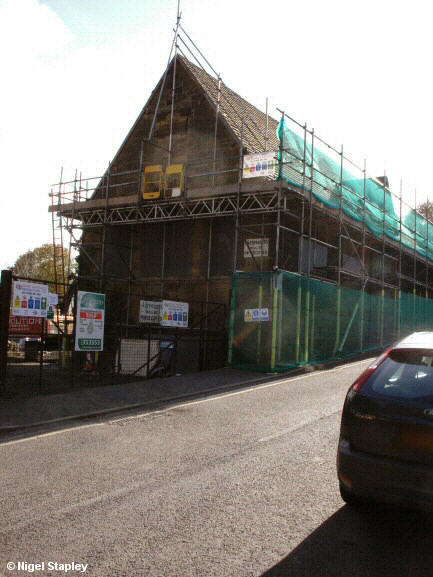
The main gable at the north-eastern end shortly before demolition, along with the entrance to the bottom yard.
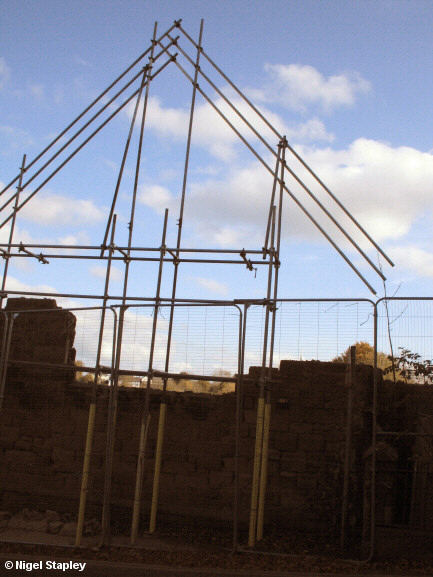
Where the gable of the Infant School stood. The whereabouts of the stone which said INFANT SCHOOL is unkown at this time.
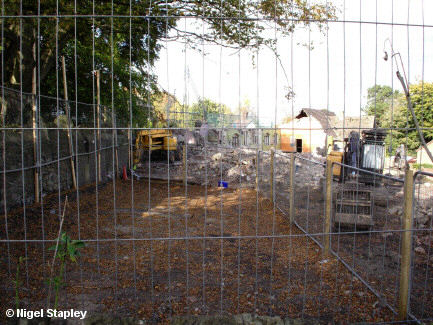
Looking from the old St John's churchyard to where the toilet block stood on the top yard.
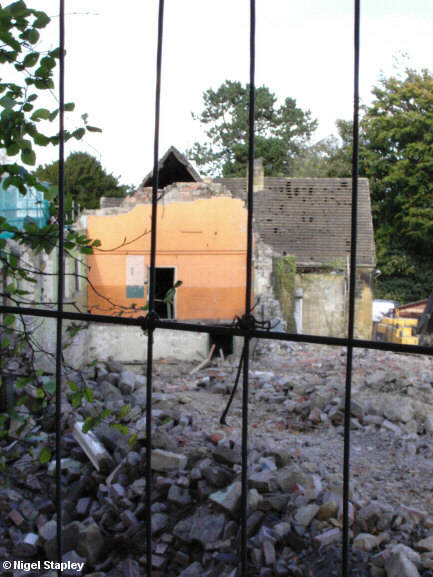
Looking towards the wall of Mrs Jones'/Mr Pritchard's classroom, with the door to the bottom level to the left-centre of the picture, the batten from which the hymn sheet used to hang up and to the right of it, and the door from the bottom-level classrooms to 'the pegs' lower-right.
I wonder if they ever found the winder from my wristwatch which I lost through the floor in about 1971?
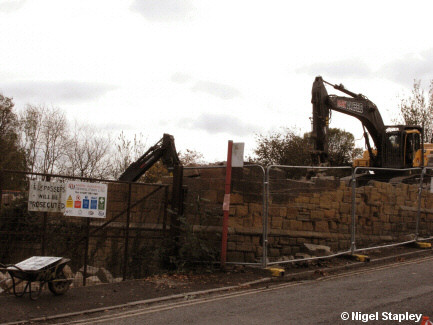
The main gable now eradicated. I wonder what has become of the name-stone which sat high up on it?
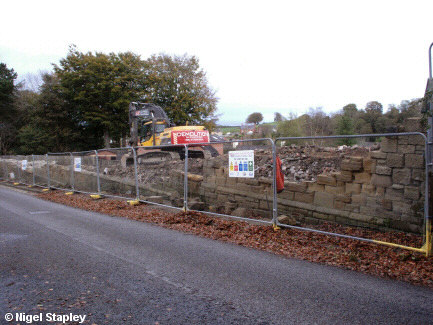
Looking along what is left of the outer wall.
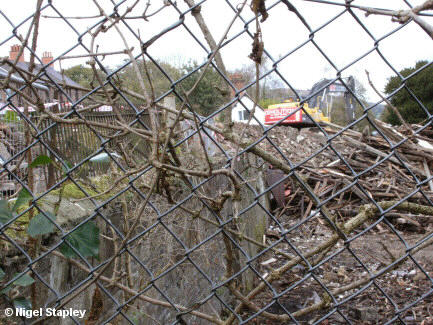
The wall between the top yard and 'the lawn', and towards the site of the caretaker's house which was demolished many years before, and was reached by a bridge from the top yard. Some of the old railings are still in situ even now.
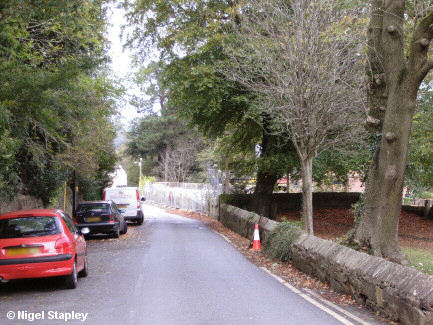
Looking down the road at a space which is now not merely physically empty, but which is a void in our lives as well.
Ave atque vale, old school. Or, as we common folk would say, "See ya". 
**********
I suppose I might as well end on a predictable note, with a song which was a hit right about the time I last set foot in the place as a pupil (as we were called back then). And, after all, it did give me the title for this piece, and finding titles is often a bigger bind than writing the article itself:











 This Is Not A
BLOG!
This Is Not A
BLOG!











